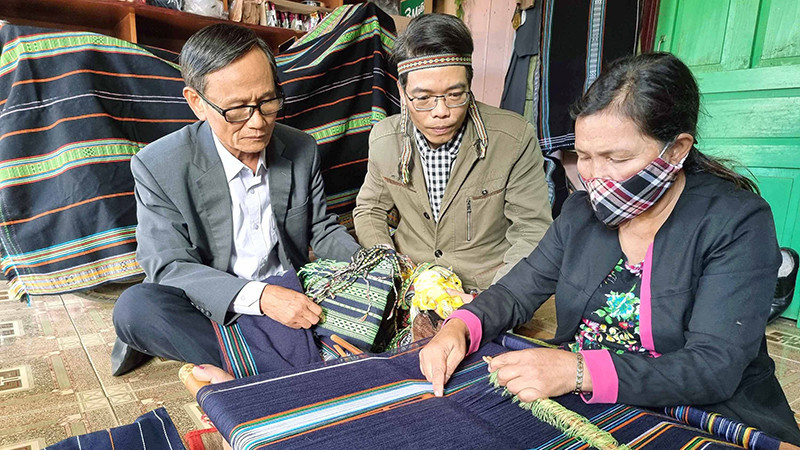Brocade is an inseparable part of life for the ethnic minorities of Vietnam’s Central Highlands. From birth to major life milestones, it accompanies every stage of existence.
A newborn is swaddled in a brocade cloth by the mother; on cold forest nights, couples share a brocade blanket filled with warmth and meaning; and no important ceremony is complete without it.
On each handwoven piece, the artisan embeds their spirit, emotions, and perceptions of the natural world and humanity through vivid decorative motifs.

Brocade patterns among Central Highlands ethnic groups commonly depict elements of nature, daily life, tools, and animals.
However, by observing the color range, structure, and specific designs, one can distinguish the brocade style unique to each community.
Among the Co Ho Cil people in the ancient village of Ja, now part of Đưng K’Nơh commune, Lac Duong district (Lam Dong), the tradition of brocade weaving is still cherished and practiced.
Meritorious Artisan Bon Nieng K’Glong sang a gentle Ndrĩ Nring song beside her spinning wheel:
"A girl must know how to weave cloth / must weave well to make fine blankets / spin diligently to lengthen the thread..."
She explained: “Back then, every girl in this village knew how to pick cotton, spin thread, and extract dyes from forest plants to weave brocade. It’s the heritage of our people. A girl had to know how to weave - its beauty lies in her hands, her eyes, in how she combines colors and patterns.”
According to artisan K’Glong, creating a brocade piece that reflects the cultural identity of the southern Central Highlands requires numerous steps: cotton planting, spinning, dyeing, framing, and weaving. The Co Ho people use a mobile loom made of 12 wooden or bamboo rods of varying sizes, each with a specific name and function. This traditional design has remained unchanged over time.
The dyeing process is particularly rich in local knowledge. Elders in Co Ho villages recall that green is derived from pounding to-rung leaves, soaking them in jars for a week, then fermenting the mixture for two more days before applying it to the threads.
Blue is made from be indigo leaves, red from amaranth-like grasses, and yellow from wild turmeric roots. The dye colors are chosen based on the product - be it a blanket (ui tong), skirt (ui ngoach), shawl (ui khan bay), headband, or bracelet.
Cultural researcher Dang Trong Ho from Da Lat notes, “Co Ho brocade features subdued tones, woven into scenes of daily life and forest culture. It reflects human relationships with nature and with one another. The motifs are crafted through specific weaving techniques - some traditional, others born from the artisan’s creativity.”
Traditional Co Ho brocade motifs often include elements of nature, animals, and familiar tools such as stilt house stairs, sawtooth patterns, dung dinh leaves, bead chains, machetes, and jars for fermented rice wine.
“Though traditional motifs are widely recognized, each artisan’s design varies,” said K’Glong. “Colors, combinations, and pattern arrangements reflect the weaver’s emotions, perspectives, and preferences - always within the bounds of tradition.”
PV